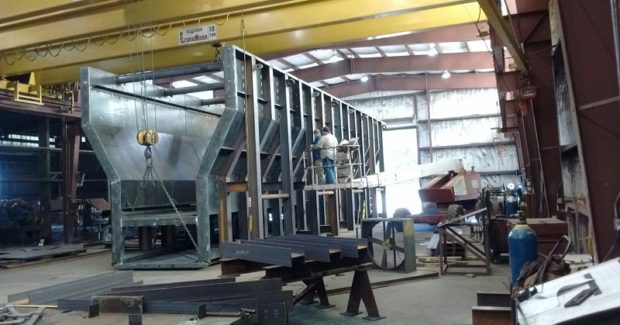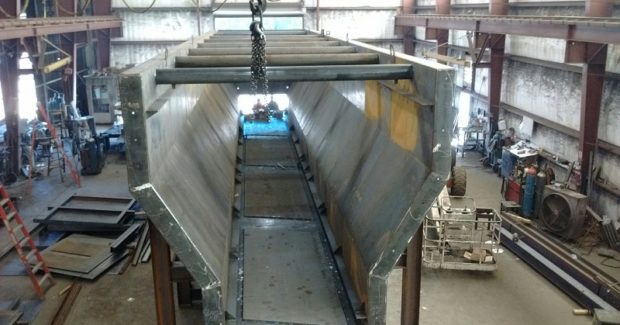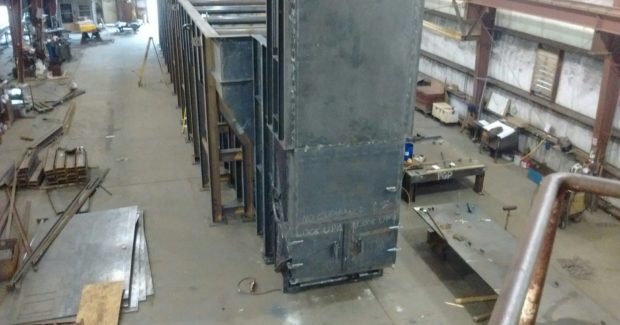How to Put Seeming Waste to Good Use
Coal-fired power plants are turning to ash removal conveyors that eliminate the need and use of ash ponds and support EPA regulations on the safe disposal of coal ash in landfills and surface impoundments. This job shop fabricated five of these large, sophisticated submerged scrapper conveyor systems, which one power plant now uses to recycle coal ash, conserve natural resources and save energy.
Posted: February 12, 2018
Coal ash, also referred to as coal combustion residuals (CCR), is created when coal is burned by power plants to produce electricity. Coal ash is one of the most abundant types of industrial waste generated in the United States. In 2012, 470 coal-fired electric utilities burned more than 800 million tons of coal, producing about 110 million tons of coal ash, according to the Environmental Protection Agency (EPA). This industrial waste is commonly disposed into ash ponds – engineered structures for disposing coal ash – in wet form in large surface impoundments and dry form in landfills. Coal ash often contains contaminants like mercury, cadmium and arsenic. Without proper management, these toxins can pollute waterways, groundwater, drinking water and the air.
Wet and dry ash handling systems have experienced gradual changes since the 1970s. More recently, power plants have turned to ash removal conveyors that are designed to eliminate the need and use of ash ponds in order to support EPA regulations on the safe disposal of coal ash in landfills and surface impoundments. As an alternative to traditional wet bottom ash hoppers and slurry systems, a Submerged Scraper Conveyor (SSC) is used for the continuous removal of bottom ash from conventional coal-fired boilers and is particularly suited for high ash rates and boiler slags. The equipment is ideal where headroom is limited. The system is capable of quenching and transporting more than 100 t/h of ash and offers higher energy efficiency than hydraulic systems of comparable capacity. A double roller crusher can be used to feed the ash either to a slurry disposal system or onto belt conveyors for onward transfer. This technology can adopt single or twin hydraulic or electro-mechanical drives to suit the application or customer requirements.
A Remote Submerged Scrapper Conveyor (or RSSC) consists of a conventional SSC that is modified to include a slurry processing system, which allows it to be located remotely from the associated boiler at or slightly above grade level, rather than directly under a boiler like a conventional SSC. One global power group contracted us for the custom metal fabrication of three SSCs and two RSSCs for a power plant located in South Carolina. We took on the task of manufacturing these five large, sophisticated submerged scrapper conveyors in our 57,000 sq ft facility. Each SSC and RSSC finished at approximately 14 ft wide by 16 ft tall by 200 ft long, and each weighed about 275,000 lb. Skilled craftsmen performed all of the plasma cutting, press brake bending, beveling, welding, drilling, torch cutting and shearing that was required on this job.
Fabricating this sort of equipment – of such large size and weight – presented our shop with a few process challenges and made material handling difficult throughout various stages of construction. Additional complications of this job required the sandblasting and painting to be completed only in fair weather conditions. Relying on specific weather conditions can cause interruptions in project completion.
After delivery and installation in the South Carolina power plant, these conveyors now allow a controlled collection and disposal of ash that eventually promotes the end of ash pond usage and need in the future. The SSCs allow the power plant to recycle the coal ash, which conserves natural resources and saves energy. Coal ash can also produce positive environmental, economic and performance benefits, such as reduced use of virgin resources, lower greenhouse emissions, reduced cost of coal ash disposal, and improved strength and durability of materials. In some cases, products made with coal ash perform better than products made without it. For example, coal ash makes concrete stronger and more durable, and also reduces the need to manufacture cement, resulting in significant reductions in greenhouse gas emissions.
Correctly managed coal ash can be put to beneficial reuse, reducing the environmental footprint that it produces. Because Americans continue to consume more electricity every year, renewable energy sources will do well in keeping up with increases in demand. Power companies will continue to burn coal and produce fly ash because so many people in the industry feel that it makes sense to put that seeming waste to good use, especially if recycling the ash can save money and energy in the construction sector.














